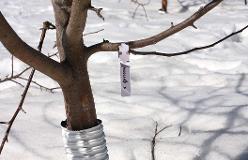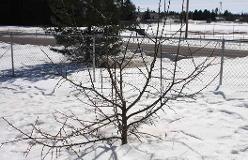Columbia Falls
updated 06/13/2021
Site description and contact

This orchard is located in Columbia Falls in Flathead County at an elevation of 3,057 ft. To see locations of all MSU Extension Fruit Research Sites and Montana Heritage Orchards, visit this interactive web map.
To coordinate a site visit, contact Pat McGlynn, MSU-Extension, (406) 758-5553, or Shari Johnson (Site Manager), Columbia Falls Junior High, (406) 892-6530.
Climate
These data originated from the nearest weather station in Kalispell, MT and were downloaded from NOAA's website. Note that elevation and environmental conditions may vary somewhat from the orchard site.
| Weather Station Elevation (ft) |
Average Total Annual Precip (in) |
Annual Average High (F) |
Average Annual Low (F) |
Extreme High Temp (F) |
Extreme Low Temp (F) |
| 2,957 | 17 | 85 | 14 | 96 | -10 |
See also: detailed climate data for all sites (opens in Figshare)
Management Practices
|
Irrigation |
Fertility management |
Weed management |
Pruning |
Deer issues? |
Fireblight presence |
Insect notes |
|
automatic sprinkler irrigation from well; watered every morning |
compost from school |
hand pull weeds; sod is cleared around tree at least 1 ft radius from trunk |
yes |
yes, until fenced in 2018 |
no |
severe codling moth, abundance of aphids on ‘Pipestone’ plums |
Cultivars Planted
Apple: 'Arkansas Black', 'Frostbite', 'Goodland', 'Honeycrisp', 'Northern Lights', 'Sweet 16', 'Zestar!'
Pear: 'Golden Spice', 'Luscious', 'Parker', 'Patten', 'Ure'
Plum: 'Mount Royal', 'Pipestone', 'Toka'
See also: full list and descriptions of the fruit tree cultivars used in this research
Orchard notes and map
Trees were initially planted in April of 2013. No rootstock information is available. Site visit notes, 3/20/2019:
- Well-maintained site; Shari (site manager/school counselor) has support from the school and access to junior high students willing to learn and work.
- The main issue is the abundance of insects, codling moths, spider mites, and aphids. Trees are producing fruit, but most of the fruit is inedible due to insect fruit damage. Note: in 2020, we are working to implement an insect management program.
- No pesticides are used because the students are often in the garden helping.
- Site favorites are the ‘Arkansas Black’ apple (which is very sweet), ‘Goodland’ apples, ‘Zestar!’ apples; all plums and pears are doing well.
- All the ‘Pipestone’ plums have an abundance of aphids.
See the printable orchard maps and data for all sites (opens in Figshare).
Photo gallery
Click image to expand and view description.
Tree survival data, fall 2019
| Cultivar & total surviving trees/total planted trees |
Total planted |
Total alive |
% survival |
|||||||
| Apple | Arkansas Black | Frostbite | Goodland | Honeycrisp | Northern Lights | Sweet 16 | Zestar! | |||
| 1/1 | 1/3 | 4/4 | 6/6 | 3/3 | 4/6 | 3/3 | 26 | 22 | 85% | |
| Pear | Golden Spice | Luscious | Parker | Patten | Ure | |||||
| 3/3 | 2/3 | 3/3 | 3/3 | 3/3 | 15 | 14 | 93% | |||
| Plum | Mount Royal | Pipestone | Toka | |||||||
| 1/3 | 0/3 | 2/3 | 9 | 3 | 33% | |||||
See also: survival data for all sites in spreadsheet format (opens in Figshare)





